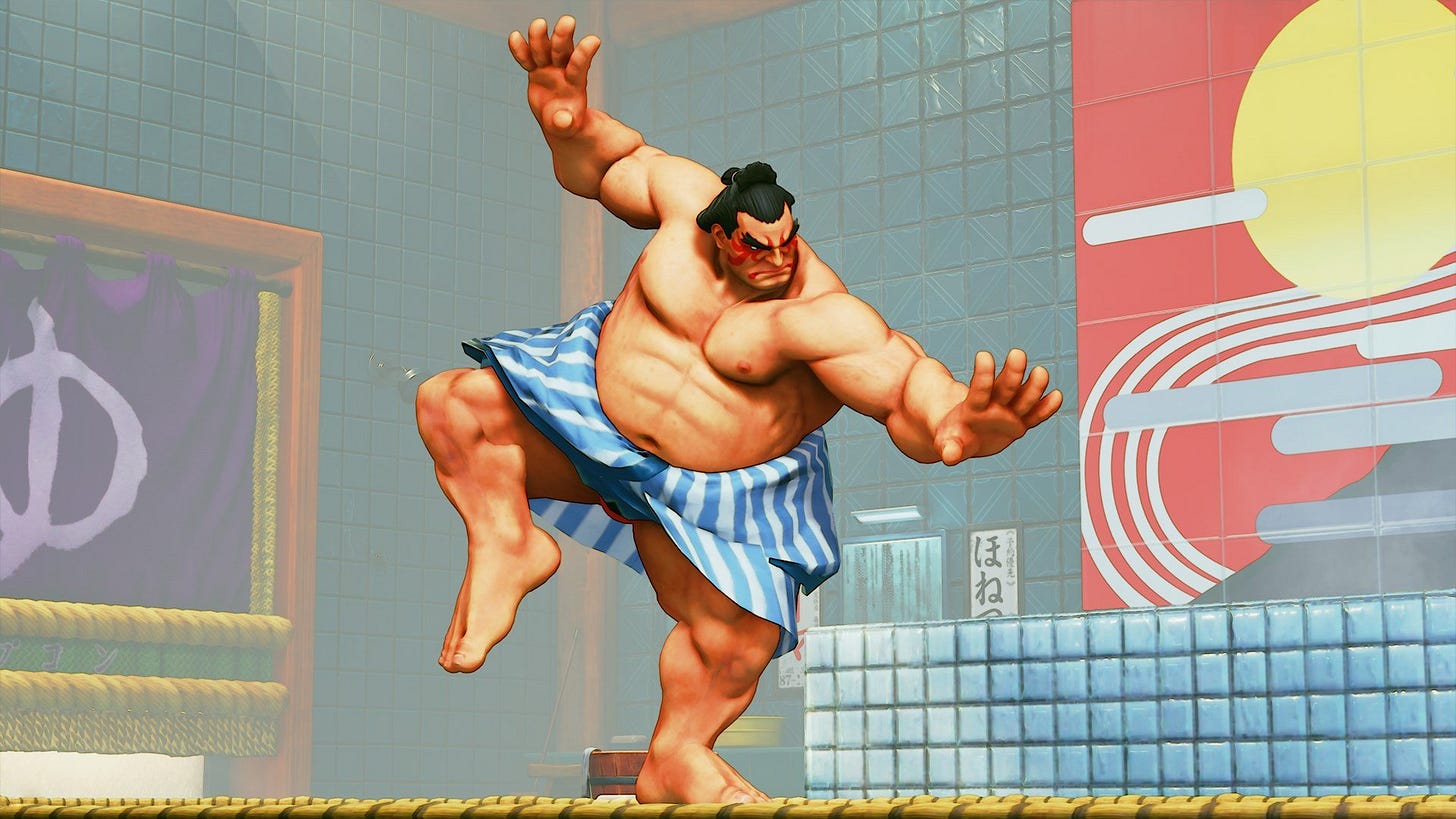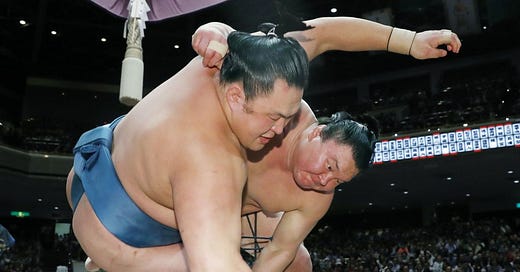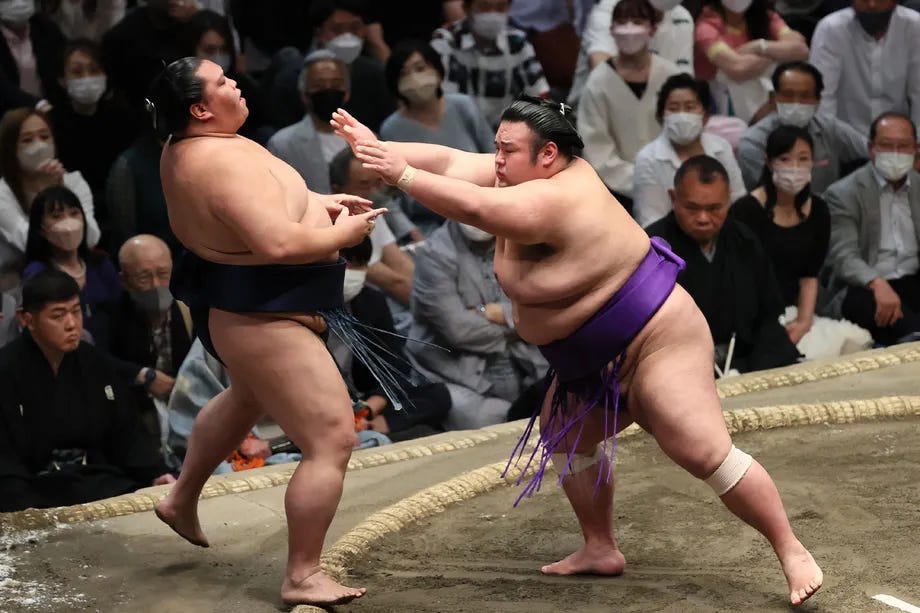I am very fortunate to be an expat living in East Asia. As part of that privilege I’ve gotten to travel around to different countries over the years and enjoy the local culture. For me, Japan’s sumo wrestling has always been fascinating, terrifyingly complex, and mythical. On a recent jaunt to Tokyo, I swung by the Sumo Museum at the The Ryogoku Kokugikan Arena to not just kill time but also take a moment to try and learn more about the sport that has been described as “fat guys in diapers pushing each other.”
First off, let’s just address the point that they’re not wearing diapers. They’re called “mawashi” and they’re very important to the culture of sumo, ok?
A Brief History of Sumo
To really understand sumo, we have to start a long ways back. Sumo has history dating back to prehistoric cave paintings in Japan. Initially, it was meant as a form of ritualistic dance to ward of evil spirits before later evolving into the sport you can watch on your TV today. According to legend the gods Takemikazuchi and Takeminakata entered into a grappling match to figure out who would decide the fate of the Japanese archipelago. This story is seen played out in different aspects of sumo’s pre-match ritual with the salt-throwing, meant to purify the match ring, and stomping the ground, to frighten off unfriendly spirits.

One of the first ever recorded bouts happened in 642 CE (AD if you don’t know what CE means) and was organized by the Japanese empress to entertain a Korean delegation. For the next millenia sumo adapted from a court ritual to becoming a popular form of entertainment.
During the Edo period, in the 17th century, sumo became restricted in its practice and thus only permitted competitors were allowed to partake in sumo competitions. That is a fancy way of saying, “Some jerks ruined everyon else’s fun.”
From here on the only permitted sumo competitions were what are called "kanjin-zumo", which were used to raise money for temples and other public works. The different groups who organized these fundraising efforts and tournaments would form into the modern sumo associations in Osaka and Tokyo. By the late 18th century, the overall structure of ranks, stables (gyms), and so on were more or less established and have been relatively set that way since. During this time sumo was ingrained as a bedrock symbol of Japanese culture thanks to Emperor Meiji and Show respectively. As a result sumo sits as both a sport and a living embodiment of cultural heritage within Japan where the ramifications of the tension it experiences are quite deep. There is much more nuance to all of this but for now that is the gist.
After World War 2, which saw sumo put on hiatus because…well…there was a big war, the sumo association in Japan formed the currently used format of sumo with 6 tournaments per year running for 15 days each.
A Fool’s Guide to Sumo
You may now be saying, “OK, that was a whole bunch of words about history you dork, but I just wanna know what the heck is going on!”
Fair enough.
In short, sumo is a high-impact grappling sport with the goal of pushing your opponent out of the ring, or making any other part of their body other than their feet touch the ground. It’s that simple. Well, not really but we’ll leave it at that (obviously you can’t head kick someone). Sumo is, oddly, very similar to a number of wrestling styles. Meaning, if you enjoy judo, wrestling, or jiu jitsu you may actually really like some sumo action. It’s also worth pointing out that there are no weight classes. Meaning you can see a 98kg guy go against someone who is double his size and that’s deemed a fair match up.
There are various leagues around the world but the big money in sumo is in Grand Sumo (aka the professional league). During the course of the 15 day tournament, each sumo wrestler faces another opponent just once and they only have a singular match once per day. The wrestler who accrues the most wins over those 15 days wins the tournament and the big stack of prize money to go with it. Also sometimes a comically large trophy.
After each tournament, the results of where a wrestler finds themselves determines the wrestlers rank in the next tournament. To put it bluntly: your rank determines everything.
Rankings
Your rank in sumo, as well as your opponent’s, determine a lot of things. Who you face, how much money you get paid, and most important what hairstyle you get to don. Win more than you lose? Your rank goes up. Lose a bunch? Down the ladder you go. Thanks to this system, as well as various other influence, higher ranked rikishi (aka sumo wrestler) will be showered in pay, privileges, and more freedom than their lower ranked teammates.
In the main sumo league there are different divisions of skill. Let’s just focus on makuuchi as that’s the one where the biggest and baddest boys compete in. There are, usually, 42 wrestlers in this division. Dividing them up further is the ranking within that division.
The ranks in makuuchi are:
Yokozuna
Ozeki
Sekiwake
Komusubi
Maegashira
You’ve probably heard the word “yokozuna” via WWE’s 1980s wrestler named…well…Yokozuna. That wasn’t an accident as they made the Samoan Agatupu Rodney Anoaʻi portray being a Japanese wrestler. Another word you may recognize from earlier, Rikishi, is also a WWE reference to sumo and also happens to be a Samoan who wasn’t an actual sumo wrestler.
Anyway I digress. A yokozuna is, well…I’d describe it as “a god of sumo that can’t be stopped” because that’s basically what you have to be to be given that title by the Sumo Association. You have to meet a list of special requirements just to get it, and usually you’re the best of the best. At any given time there are between 1 to 4 yokozuna and usually when you lose the title you’ve retired. In addition, there are special pre and post match ceremonies the yokozuna get to do thanks to their prestigious rank.
Beneath them is the ozeki who, like the yokozuna, must meet special requirements to be given that rank and are usually some of the best wrestlers in the whole of sumo.
Both the ozeki and yokozuna get a lot of eyeballs on them, and basically live under a microscope with a lot of people scrutinizing not only their matches but their personal behavior outside of the ring.
Below them are the sekiwake, komusubi, and maegashira who are all battling it out just to get ahead in the rankings and get more prize money for their efforts. Within the maegashira ranks there is another ranking method shown as any number between 1 to 16. This helps signify where within the maegashira rank a wrestler lies. So if a wrestler is shown to be a “M1” that means they’re a highly ranked maegashira and potentially close to reaching komusubi status as compared to say a wrestler with the “M11” signifier.
All of these ranks are recorded on a banzuke, which is a piece of paper with a wrestler’s name on a chart breaking down who is ranked where. Two weeks before a new tournament, a new banzuke is released. These in turn become somewhat popular collector’s items as they shift and change each tournament and can help commemorate some of the story lines within the sport.
In Part 2, I’ll explain what the hell is going on when you watch a sumo event as well as share some of the more interesting stuff I found while wandering around the Ryogoku Kokugikan in Tokyo, one of the biggest sumo venues and steeped in history and sumo sporting culture. Additionally, Japan’s NHK television channel has some great content to help fill in the gaps if you’re curious to do your own research.
If this has piqued your interest in Sumo then have I got good news for you! The March 2023 tournament, Haru Basho, is happening soon! It’s going to be held between March 12th to the 26th in Osaka, Japan. Typically you can only view it on NHK (who do provide English commentary) though there are plenty of YouTubers who upload highlights and recaps, as well as a couple of Twitch streamers who will stream the whole event live, as well as an entire back catalog of content going back to 2009 someone put onto Archive.org, for your viewing pleasure. However, NHK has been pretty strong with their copyright strikes etc. so if Twitch fails you can always get a VPN and watch, for free, on NHK’s website or on the Japanese streaming site Abema TV.







